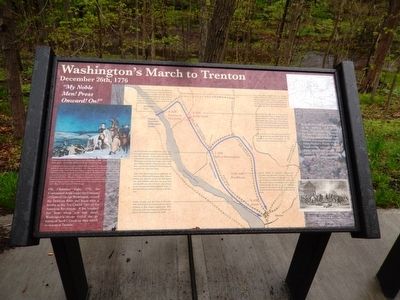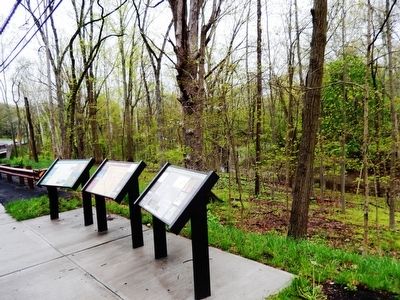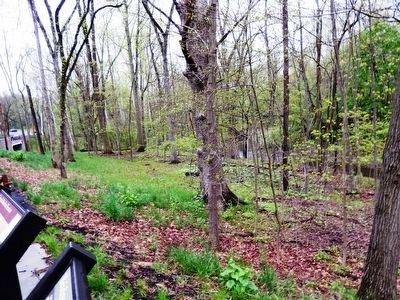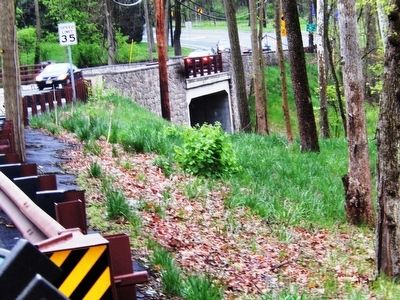Ewing Township in Hopewell Township in Mercer County, New Jersey — The American Northeast (Mid-Atlantic)
Washington’s March to Trenton
December 26th, 1776
— “My Noble Men! Press Onward! On!” —
4 AM Landing in New Jersey
Delayed by inclement weather and the difficulty of transporting heavy artillery, it was nearly 4 am by the time the army was fully across the Delaware River. News of the crossing quickly spread and local New Jersey volunteers joined the army as guides, helping the Continentals navigate the dark road and circuitous inland route.
Four hours behind schedule, the army trudged roughly a mile and a half inland from the river along an icy road and it came to a crossroads on the Bear Tavern. There the army turned southeast onto Bear Tavern Road, which was southward along high ground, directly toward the village of Trenton.
6 AM Jacobs Creek
Around 6 am, the army came to a large stream called Jacob's Creek. With no bridge in place, the army was forced to wade through the treacherous storm swelled creek waters. The army wasted yet more precious time securing their cannons to nearby trees, which they used as mooring ports to lower the guns to the bottom of the ravine through which the creek ran.
Once across the creek, the nearly two-ton guns had to be hauled up steep creek banks, while the men struggled to keep their footing against the cold, slippery conditions and fought off exhaustion.
7 AM Split at Birmingham
At the end of Bear Tavern Road, the column came to a small crossroads settlement called Birmingham (now West Trenton). It was nearly 7 am, and the army was still only half way to Trenton. As planned, Washington ordered the army to split, with General John Sullivan’s division taking the southern River Road, and General Nathaniel Greene leading his division to the Upper Ferry Road.
Upper Ferry Road winded its way uphill from the river to Scotch Road and Pennington Road. Greene’s division was ordered to set out from Birmingham first, while Sullivan, whose route was more direct and downhill, was told to “halt for a few minutes at the cross road which leads to Howell’s Ferry,” so that both divisions could reach Trenton at the same time.
7:30 AM Roadblocks
Around 7:30 am, the American columns were still about two miles from Trenton. The storm still raging, it was dark and difficult to see. The men struggled to keep their flints and powder dry. The advance parties were already in place, having worked through the night to set up roadblocks around Trenton and cut off all communications between the town and countryside in the west and north.
8 AM Attack
despite all odds, just after 8 am on December 26th, both wings of the Continental Army found themselves in place almost simultaneously. With all but one of the major routes out of Trenton now blocked, the Americans prepared for attack.
(Inscription in the box on the right)
Ironically, the delays at the crossing of the Delaware and Jacob’s Creek may actually have sealed the American victory at Trenton. After being on high alert all night because of an unauthorized raid by Adam Stephen’s Fourth Virginia Regiment, the exhausted Hessian troops relaxed just enough after sunrise to be taken completely by surprise by Washington’s attack.
Topics. This historical marker is listed in this topic list: War, US Revolutionary.
Location. 40° 17.448′ N, 74° 50.426′ W. Marker is in Hopewell Township, New Jersey, in Mercer County. It is in Ewing Township. Marker is on Jacobs Creek Road. Touch for map. Marker is at or near this postal address: 117 Jacobs Creek Rd, Titusville NJ 08560, United States of America. Touch for directions.
Other nearby markers. At least 8 other markers are within 2 miles of this marker, measured as the crow flies. Geography & Historic Landscape of Jacobs Creek (here, next to this marker); Bridges, Roads, and Railroads of Jacobs Creek (here, next to this marker); Washington’s March To Trenton (about 400 feet away, measured in a direct line); First Hunterdon County Militia (about 500 feet away); Bear Tavern Road (approx. 0.2 miles away); Mercer Airport (approx. ¾ mile away); Continental Lane (approx. 1.4 miles away); The March to Trenton (approx. 1.4 miles away). Touch for a list and map of all markers in Hopewell Township.
Credits. This page was last revised on December 13, 2023. It was originally submitted on May 21, 2016, by Don Morfe of Baltimore, Maryland. This page has been viewed 565 times since then and 50 times this year. Last updated on December 2, 2023, by Carl Gordon Moore Jr. of North East, Maryland. Photos: 1, 2, 3, 4. submitted on May 21, 2016, by Don Morfe of Baltimore, Maryland. • Michael Herrick was the editor who published this page.



